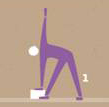Using a Yoga Block in Trikonasana
If you look at the shape of Trikonasana (Triangle Pose) it’s easy to see that a whole lot of what feels great about it is its expansion and openness. But sometimes when we reach what we think is our “fullest expression” of Triangle, we find it becomes hard to breathe freely, or we may feel collapsed or contracted, especially in the front of the torso—anything but expansive.
There are many reasons that our Trikonasana might not look and feel as expansive as we’d like. The most common reason is that there’s a misunderstanding that practicing a “full” Trikonasana means we have to reach our hand down to the floor. If your legs are especially long, your stance is narrow, or if your hamstrings are on the tighter side, reaching your hand to the floor may compress your Trikonasana, which takes a lot of the joy out of it.
Placing a yoga block under your hand, on the outside of your front foot, can expand your Trikonasana, which frees your breath and energizes your body. Each yoga block has three levels, low, medium and high, depending on whether you place it flat, on its side or on its end. Judith Hanson Lasater calls the three levels Baby Bear, Mama Bear and Papa Bear. The block in the photo is in Mama Bear mode.
Depending on which yoga block you use—4-inch foam, bamboo, 3-inch foam, recycled foam, wood or cork—some of the measurements may be slightly different (an inch or less) but any of these will work nicely for Trikonasana. The best way to judge which level works best for you is to check in with your breathing as you practice. If your breathing feels restricted or shallow, turn your block so that it’s higher. You can stack one on top of another if need be. If you stack two blocks, always place bottom one flat on the floor for stability. Or better yet, you can use our Big Block for extra height.
Flexies can benefit from practicing Trikonasana with a block too. Even if you’re flexible enough to place your hand on the floor easily it can be useful, even exhilarating, to practice with a block. Try it and enjoy maximum expansion!
More Ways to Enjoy Your Yoga Block
 For more ideas about using yoga blocks and other props, visit this fun and informative Prop Guide on our website.
For more ideas about using yoga blocks and other props, visit this fun and informative Prop Guide on our website.

Charlotte — you always have interesting insights that you share so well! I love to see all the different materials for blocks as I encourage folks to feel the block, first, and then use it as a point from which to lift. Sometimes folks lean … so having a choice of blocks can increase the sensory experience while fostering that sense of expansion. thanks for sharing your ideas! Yael
Thanks for your comment! It’s true that people do lean into the blocks. For me that feels as if all the energy drains out of the pose. I like to suggest to students that they actively root their hand into the block. This creates an energy rebound that sequences through the body.